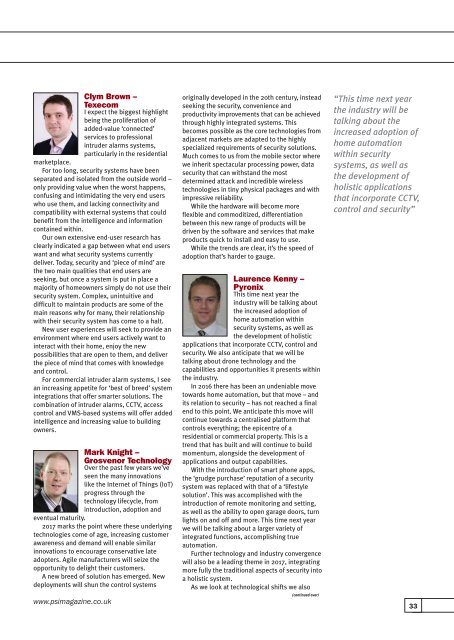PSIJan2017
You also want an ePaper? Increase the reach of your titles
YUMPU automatically turns print PDFs into web optimized ePapers that Google loves.
Clym Brown –<br />
Texecom<br />
I expect the biggest highlight<br />
being the proliferation of<br />
added-value ‘connected’<br />
services to professional<br />
intruder alarms systems,<br />
particularly in the residential<br />
marketplace.<br />
For too long, security systems have been<br />
separated and isolated from the outside world –<br />
only providing value when the worst happens,<br />
confusing and intimidating the very end users<br />
who use them, and lacking connectivity and<br />
compatibility with external systems that could<br />
benefit from the intelligence and information<br />
contained within.<br />
Our own extensive end-user research has<br />
clearly indicated a gap between what end users<br />
want and what security systems currently<br />
deliver. Today, security and ‘piece of mind’ are<br />
the two main qualities that end users are<br />
seeking, but once a system is put in place a<br />
majority of homeowners simply do not use their<br />
security system. Complex, unintuitive and<br />
difficult to maintain products are some of the<br />
main reasons why for many, their relationship<br />
with their security system has come to a halt.<br />
New user experiences will seek to provide an<br />
environment where end users actively want to<br />
interact with their home, enjoy the new<br />
possibilities that are open to them, and deliver<br />
the piece of mind that comes with knowledge<br />
and control.<br />
For commercial intruder alarm systems, I see<br />
an increasing appetite for ‘best of breed’ system<br />
integrations that offer smarter solutions. The<br />
combination of intruder alarms, CCTV, access<br />
control and VMS-based systems will offer added<br />
intelligence and increasing value to building<br />
owners.<br />
Mark Knight –<br />
Grosvenor Technology<br />
Over the past few years we’ve<br />
seen the many innovations<br />
like the Internet of Things (IoT)<br />
progress through the<br />
technology lifecycle, from<br />
introduction, adoption and<br />
eventual maturity.<br />
2017 marks the point where these underlying<br />
technologies come of age, increasing customer<br />
awareness and demand will enable similar<br />
innovations to encourage conservative late<br />
adopters. Agile manufacturers will seize the<br />
opportunity to delight their customers.<br />
A new breed of solution has emerged. New<br />
deployments will shun the control systems<br />
www.psimagazine.co.uk<br />
originally developed in the 20th century, instead<br />
seeking the security, convenience and<br />
productivity improvements that can be achieved<br />
through highly integrated systems. This<br />
becomes possible as the core technologies from<br />
adjacent markets are adapted to the highly<br />
specialized requirements of security solutions.<br />
Much comes to us from the mobile sector where<br />
we inherit spectacular processing power, data<br />
security that can withstand the most<br />
determined attack and incredible wireless<br />
technologies in tiny physical packages and with<br />
impressive reliability.<br />
While the hardware will become more<br />
flexible and commoditized, differentiation<br />
between this new range of products will be<br />
driven by the software and services that make<br />
products quick to install and easy to use.<br />
While the trends are clear, it’s the speed of<br />
adoption that’s harder to gauge.<br />
Laurence Kenny –<br />
Pyronix<br />
This time next year the<br />
industry will be talking about<br />
the increased adoption of<br />
home automation within<br />
security systems, as well as<br />
the development of holistic<br />
applications that incorporate CCTV, control and<br />
security. We also anticipate that we will be<br />
talking about drone technology and the<br />
capabilities and opportunities it presents within<br />
the industry.<br />
In 2016 there has been an undeniable move<br />
towards home automation, but that move – and<br />
its relation to security – has not reached a final<br />
end to this point. We anticipate this move will<br />
continue towards a centralised platform that<br />
controls everything; the epicentre of a<br />
residential or commercial property. This is a<br />
trend that has built and will continue to build<br />
momentum, alongside the development of<br />
applications and output capabilities.<br />
With the introduction of smart phone apps,<br />
the ‘grudge purchase’ reputation of a security<br />
system was replaced with that of a ‘lifestyle<br />
solution’. This was accomplished with the<br />
introduction of remote monitoring and setting,<br />
as well as the ability to open garage doors, turn<br />
lights on and off and more. This time next year<br />
we will be talking about a larger variety of<br />
integrated functions, accomplishing true<br />
automation.<br />
Further technology and industry convergence<br />
will also be a leading theme in 2017, integrating<br />
more fully the traditional aspects of security into<br />
a holistic system.<br />
As we look at technological shifts we also<br />
(continued over)<br />
“This time next year<br />
the industry will be<br />
talking about the<br />
increased adoption of<br />
home automation<br />
within security<br />
systems, as well as<br />
the development of<br />
holistic applications<br />
that incorporate CCTV,<br />
control and security”<br />
33

















